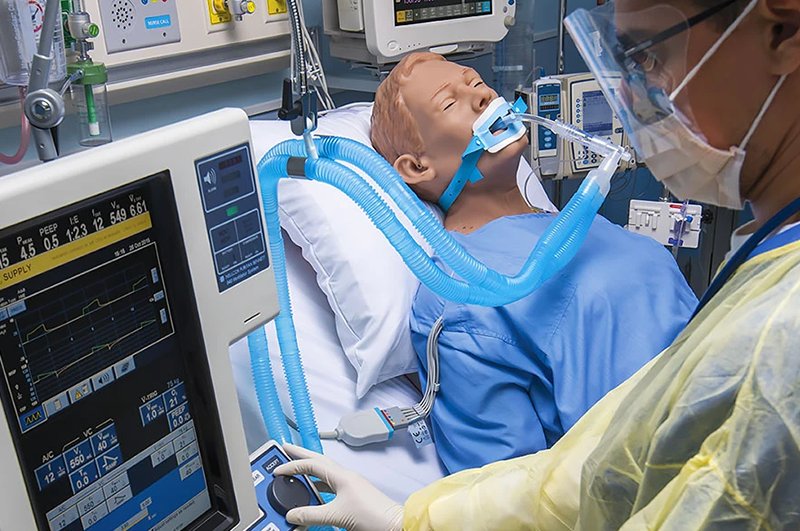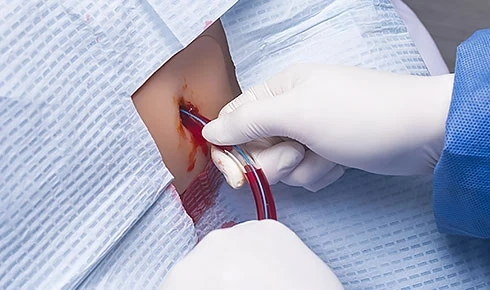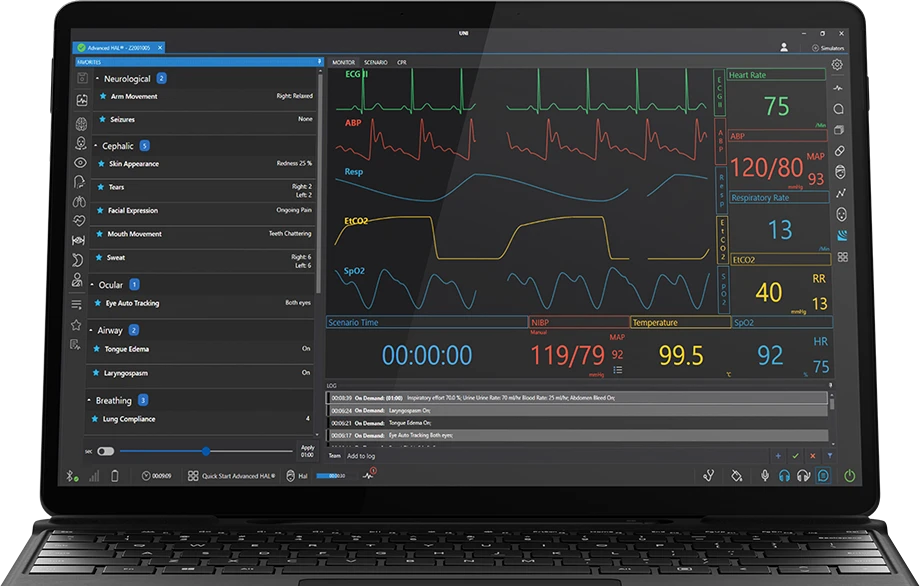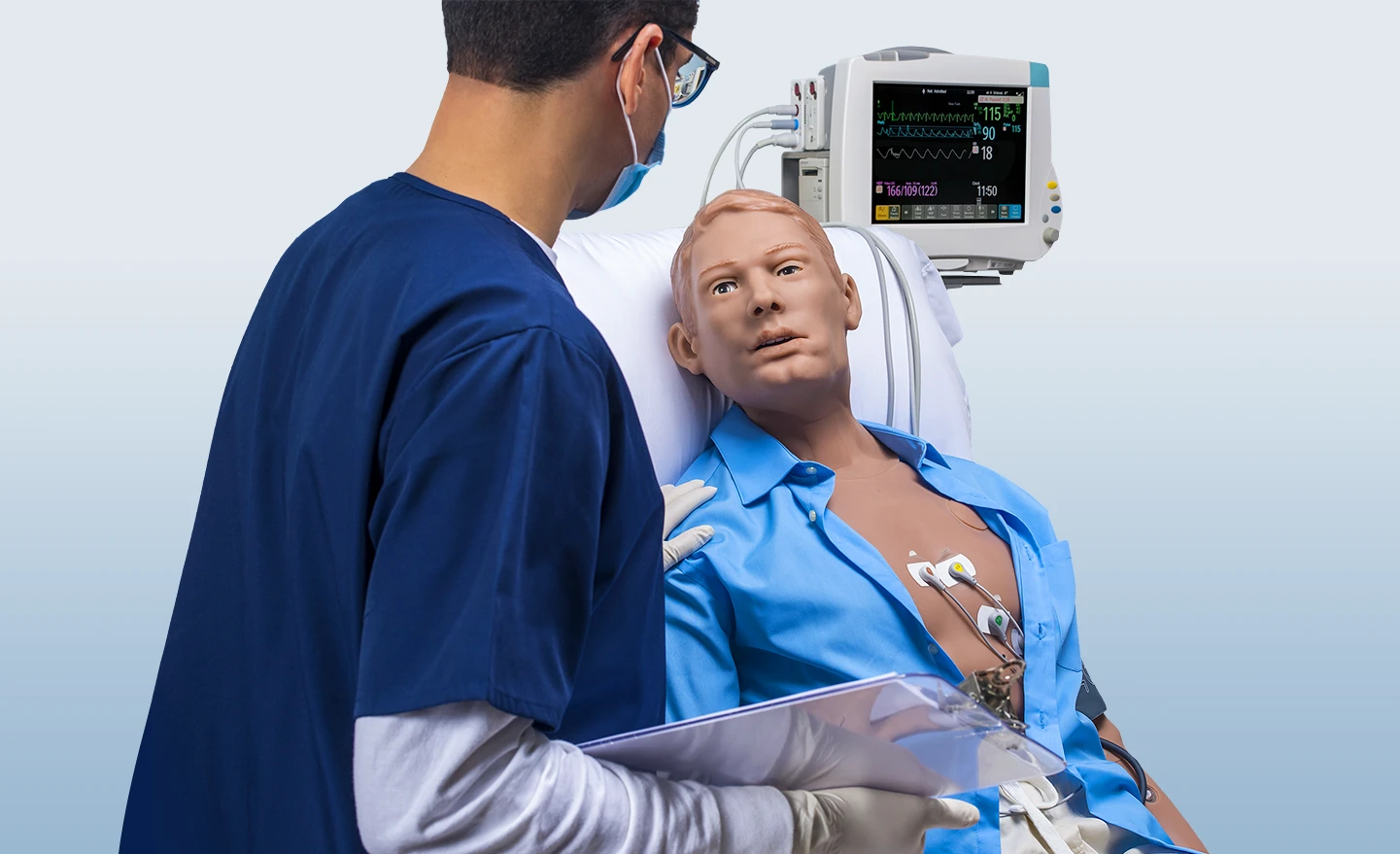- Anatomically accurate adult male proportions; height 5’ 9” / 175 cm1
- Lifelike skin features palpable landmarks and seamless articulating joints: neck, jaw, shoulders, elbow, wrists, fingers, hips, knees, ankles
- Realistic articulation supports common patient positions: supine, prone, Fowler’s
- Wireless and tetherless; all features are fully operational during transport2
- Internal rechargeable battery provides hours of tetherless operation3
- Microsoft Surface Pro preloaded with UNI® 3.0 Unified Simulator Control Software
- HAL S5301 Simulation Learning Experiences™ scenario package
- Supports Bluetooth, Gaumard RF, and wired connectivity4
- Compatible with Gaumard Ultrasound™
- Compatible with Care in Motion™ audio & video debriefing system
- Available in light, medium, or dark skin tone at no extra charge5
- Programmable blinking rate, pupil dilation, and eye movement
- Programmable consensual and nonconsensual pupillary response to light stimuli
- Normal and abnormal eye movements and conditions including strabismus, ptosis, and more
- Interactive eyes can follow a moving object
- Gaumard Conversational Speech enhanced by artificial intelligence; HAL listens and automatically answers patient history and initial assessment related questions
- » Auto-generated, natural-sounding voice
- » Scenario and patient profile dependent responses
- » Follows voice commands including lift arm, look left, look right, and squeeze hand
- » Varies verbal responses consistent with level of consciousness and physiological state
- » Gaumard Speech Processing Model: learns and improves understanding and verbal responses over time
- Wireless streaming voice: be the voice of HAL and listen to participants’ responses in real-time6
- Includes large library of high-quality, prerecorded English and Spanish responses
- Record and playback custom speech phrases in any language
- Active mouth movement synchronizes with voice: close, open, smile, unilateral lip droop, and lockjaw
- Active neck movement: rotation, flexion, extension, and reduced cervical movement
- Sound localization: HAL automatically turns head and eyes toward the provider speaking
- Active robotics simulate lifelike expressions; preset library includes left facial droop, right facial droop, pained, quizzical, scared, smiling
- Preprogrammed emotional states automatically express non-verbal cues: normal, worried, anxious, and lethargic
- Active right arm motor reflex: shake hand, squeeze hand, raise arm, withdrawal response, and abnormal posturing (decorticate/ decerebrate)
- Lifelike stroke clinical presentations include facial droop, weakness in the right arm, abnormal posturing, and pain response
- Programmable, automated pain response to pressure sensitive sites: bilateral supraorbital notch, trapezius pinch
-
Supports Train of Four monitoring using real devices
-
Lifelike partial tonic-clonic and non-tonic-clonic seizures
-
Programmable sweating (diaphoresis) and tears
- Anatomically accurate oral cavity and airway
- Normal and abnormal airway sounds synchronized with spontaneous and/or assisted ventilations
- Supports airway management using standard adjuncts including endotracheal tube (ET), supraglottic airway devices, laryngeal tube, oropharyngeal airways (OPA), and nasopharyngeal airways (NPA)
- Programmable difficult airway: tongue edema, laryngospasms, and pharyngeal swelling
- Endotracheal intubation placement detected and logged
- Right mainstem intubation automatically presents anatomically correct unilateral chest rise
- Supports “can’t intubate/can’t ventilate” scenarios
- Surgical airway supports tracheotomy, cricothyrotomy, and retrograde intubation
- Supports oral, nasopharyngeal, and tracheostomy suctioning exercises7
- Lifelike, spontaneous breathing with selectable normal and abnormal patterns
- Four anterior and posterior lung auscultation fields; new lung sound library
- Programmable bilateral or unilateral chest rise
- Fully internal, patented dynamic lungs and airway support the use of real mechanical ventilators and standard patient circuits; no calibration, proprietary adapters, or external converter adjuncts required
- Supports standard mechanical ventilators and modes of ventilation including:
- » Continuous mandatory ventilation (CMV), volume assist/control, pressure assist/control, pressure support ventilation (PSV), pressure or volume controlled synchronized intermittent mandatory ventilation (SIMV), continuous positive airway pressure (CPAP)
- » Supports therapeutic levels of PEEP
- Programmable advanced airway and lung functions
- » Variable lung unit compliance
- » Variable bilateral and unilateral bronchi resistance
- » Inspiratory effort and rate
- » Respiratory drive
- » Real CO2 exhalation
- » Auto-PEEP
- Advanced respiratory effort simulation allows for lifelike weaning/liberation scenarios
- Supports mechanical ventilation while fully mobile
- Left hemo/pneumothorax site supports palpation, incision, chest tube insertion, chest tube placement detection, bleeding, and suture
- Needle thoracentesis site supports needle insertion, detects needle placement, and presents audible hiss
- Presents normal to abnormal capnography waveforms on real devices, including “shark fin” waveform
Aortic, pulmonic, tricuspid, and mitral auscultation fields and new heart sound library
• Supports 4-lead and 12-lead ECG monitoring using real monitoring devices
• Generate cardiac injury, ischemia, and necrosis using the UNI® 3D Myocardial Infarction Model; monitor resulting abnormal ECG rhythms on a real 12-lead ECG monitoring device
• Customize 12-lead waveforms with 12-lead ECG designer interface
• ECG-derived respiratory monitoring
• Supports standard defibrillation, double sequential defibrillation, cardioversion, and pacing with live energy
• Allows for anterior/lateral and anterior/posterior pad placement
• eCPR™ real-time quality feedback and reporting: Time to CPR, compression depth/rate, compression interruptions, ventilation rate, excessive ventilation, smart CPR coach
• Bilateral palpable pulses: carotid, brachial, radial, femoral, popliteal, pedal
• Pulse palpation detection and event logging
• Programmable circumoral skin coloration: cyanosis, redness, and pallor
• Programmable oxygen saturation; monitor using real pulse oximetry sensors on the left middle finger
• Supports non-invasive auscultatory and oscillometric blood pressure measurement with real monitors and devices
• Monitor intra-arterial blood pressure using real adjuncts, sensors, and devices
• Bilateral IV access sites support cannulation with flashback, infusion, and sampling
• Radial arterial access site supports catheterization, flashback, sampling, and IBP monitoring
• Antecubital vein blood draw site on left arm
• Automatic drug recognition detects virtual medications injected into the lower left arm
• Fingerstick glucose testing on the left index finger
• Tibia and humeral intraosseous access and infusion
• Programmable capillary refill time testing located on right middle finger
• Intramuscular injection site on left deltoid
• Male urinary catheterization with programmable fluid return
• Computer-controlled urinary output rate and urine and/or blood mixture
• Programmable urinary incontinence
• Internal, auto-refilling 0.7 liter urine reservoir
• Four bowel auscultation fields and new bowel sound library
• Visible gastric distention during excessive bag valve mask ventilations and/or esophageal intubation
• Internal, auto-refilling 1.2 liter blood reservoir
• Abdominal bleeding wound responds to pressure and packing
• Optional trauma arm and trauma leg accessories feature bleeding wound and tourniquet placement detection
• Computer-controlled blood pressure-dependent bleeding






